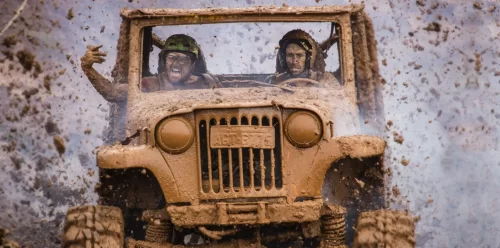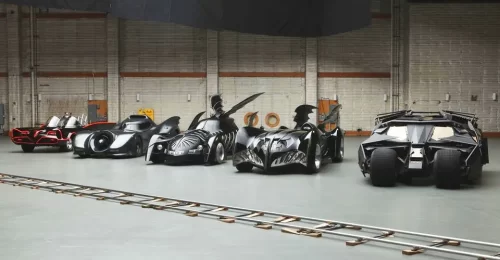
Navigating the Jeep YJ’s Impact on Off-Roading Culture
In production from 1986 to 1995, the Jeep YJ is the first generation of the Jeep Wrangler series. It succeeds the earlier Jeep CJ (Civilian

Part Three of a Three-Part Series
Gone are the sweeping curves of the Tim Burton/Joel Schumacher Batmobiles. In the new trilogy of “Dark Knight” Batman movies, Batman Begins (2005), The Dark Knight (2008), and The Dark Knight Rises (2012), director Christopher Nolan and designer Nathan Crowley brought the ruggedized paramilitary “Tumbler” to life.
The behemoth Tumbler was a departure from previous bat-motif Batmobiles in every sense of the word. Built from the ground up with no “farmed” car parts, this off-road-esque vehicle was described as a cross between a Lamborghini and a Humvee, with futuristic tank-like styling. It dismissed the long, sleek, limo-like Batmobiles for something that could tear up the side of mountains and stomp villains in a single pounce. (Sorry Superman.)
It was low to the ground, and ridiculously fast, for a movie car. Powered by a 5.7 liter, 400-horsepower Chevy 350 V8, it achieved a cruising speed of 100 mph. Sporting Hoosier racing tires up front, and Super Swampers in the rear, it could do a 0-60 run in 5.6 seconds.
It was 15 feet long and nine ft. wide, and despite its hefty 7,000 lbs. curb weight, the suspension could hold the Tumbler around tight corners, even when the outside wheels lift off the ground. Plus, it could literally jump 30 feet on its own, and continue in a scene without having to cut filming.
There are exterior cameras linked to two LCD screens, affording the driver an unobstructed view of their domain. The signature jet engine was powered by onboard liquid propane, and the whole vehicle was so loud, the crew was required to wear noise-canceling headphones!
The Tumbler featured a front-mounted Gatlin gun, unlike previous models, for a more fearsome look. Other armaments include harpoons, spikes, chemical sprays, and an electrically-charged exterior. There are also anti-ballistics systems, stealth mode ability, night vision mode, sonar, and more. It even had a ride-suspension switch, for street driving or criminal-chasing driving.

Clearly intended to take a beating, (in the movies), the Tumbler Batmobile was actually built to withstand the brutal abuse of stunt filming. Director Chris Nolan has a pension for shooting as much action “in-camera” as possible, reducing the need for CGI, (Computer Generated Imagery), and conveying the visceral energy of live-action to the audience. If the bigger-than-life footage didn’t make the cut, Nolan turned to miniatures and only resorted to CGI if all else failed.
But to ensure that Tumbler could sustain its structural integrity, the engineers and fabricators built a beast, not a prop. Where previous Batmobiles were built around an existing production vehicle frame, the Tumbler was a one-off masterpiece.
Amusingly, the Tumbler was so fast, for a movie car, that it regularly outran the camera truck filming it. Oscar-winning special effects veteran of the James Bond movie franchise, Chris Corbould, describes working on the Tumbler Batmobile with Nolan and Crowley, “We geared it for faster acceleration,” Corbould said. I remember when we came back to film Dark Knight Rises, the production crew said,
“We’ve got you this time, we super-charged the camera truck.’ His response: Well, we super-charged the Batmobile as well!”
“Initially I had reservations about building the Tumbler to the specs they requested because I thought it would all be CGI anyway. I couldn’t build a real flying thing like that,”
“But, when I got talking to them, I quickly learned that Nolan and Crowley wanted us to do as much as we could in-camera, to keep the CGI to a minimum. We ended up building a special truck that enabled it to go up and down, bank left and right. We also hung it on high wires between two cranes, so when you see it first come out of the alleyway, that’s on wires. We even went to the extreme of suspending it under a heavy-lift helicopter to fly it across building tops.”
 Four Tumblers were built, at a cost of $250,000 each, and worth every penny for its crushing, ramming, and blasting capabilities.
Four Tumblers were built, at a cost of $250,000 each, and worth every penny for its crushing, ramming, and blasting capabilities.
Each Tumbler had a purpose. The interior of the ‘race ready’ Tumbler was just a steel frame with very little visibility; for filming a static scene, a more luxurious interior was created to allow for cameras to pan and zoom.
A smaller, 20 percent size Tumbler was created to film the flying scenes. But the jumps and high speeds were all possible with the full-size version.
The jet-engine Tumbler was also very real: massive propane tanks bolted into the vehicle gave an authentic jet effect.
According to the television show Top Gear, you can own a street-legal tumbler for a cool $1 million. According to Vijay Pattni, it has a GM-sourced 5.7 liter LS1 V8 engine, and monster 44-inch tires, just like the movie vehicle. It has a custom frame and chassis, an automatic transmission, custom windows, five cameras, and the ability to scare the s#!t out of other drivers on the road. (Especially if you’re in their rear-view mirror.)
To replace the Batmobile after The Dark Knight Rises, a new vehicle was designed for Batman v Superman: Dawn of Justice. Sporting a trimmer look, its evolution retained the heavily-armored design, with cleaner lines, a more traditional wheel configuration, wider tires, and a lower, road-hugging stance.
According to the licensing information, the new Tumbler could reach a top speed of 205 mph.
The most recent addition to the Batmobile lineage is the Night Crawler, a new, everything-able vehicle that can also “transform” into a nimble spider-like contraption. In Crawler mode, the vehicle is 25-30 feet in height, and the legs can pierce almost any surface. This vehicle is completely new to the Batman universe, and storyline-wise, Batman’s father was the man behind the design, but the ride was stored away in an abandoned warehouse.
The Bat debuted in The Dark Knight Rises and was Batman’s aircraft of choice for vaping villains. It was inspired by Harrier jump-jets, with F-35B swiveling nozzles, and Osprey rotors. The Bat was a full-sized vehicle, 28 feet long and 17 feet wide. Two were created. One for filming on the ground that topped the scales at 1.7 tons, and the other, (much lighter), version for wire rigging. They hung The Bat off a 10-foot high hydraulic arm attached to a crane truck and drove it through the streets of LA, Pittsburgh, and New York at 50 mph.
The Batpod was a motorcycle-like vehicle that ejects from the rest of the car in extreme situations. Of course, the rest of the body self-destructs. It features enormous 31-inch Hoosier racing tires, combined with a prone riding profile, and a gargantuan 149.5-inch length. The bike’s unique design required the exhaust pipes be routed within the framework, and the 750 cc Honda motorcycle engine is wrapped inside the fiberglass bodywork.”
If you want to create a replica Batmobile of your own, bolt in a world-class FRASER remanufactured engine and speed through Gotham City!

In production from 1986 to 1995, the Jeep YJ is the first generation of the Jeep Wrangler series. It succeeds the earlier Jeep CJ (Civilian

T’was Christmas Eve In New York City THIS HOLIDAY CLASSIC FILM FEATURES A 1970 CHECKER MARATHON SEDAN TAXICAB. Scrooged – Featuring a 1970 Checker Marathon Cab

The 100% death proof weapon of choice for Stuntman Mike Quentin Tarantino proves that cars are freaking terrifying! Referred to as Tarantino’s worst movie, Death

Issue 32 • Engine & Transmission Tips Get pro results turning your wheels into the super popular matte black look! You’ve got what were once

Whee Anything That Could Go Wrong, Does… perfectly! This classic holiday movie features a 1937 Oldsmobile F-37 Six Touring Sedan. If you are not familiar

The Ford Econoline, also known as the E-Series, holds a special place in the automotive landscape as one of the most recognizable and versatile vans